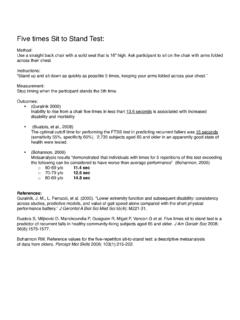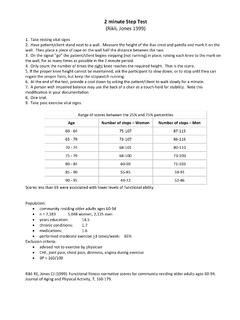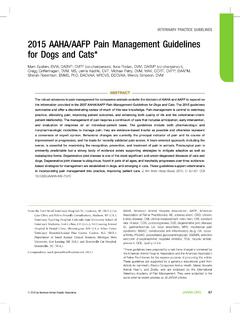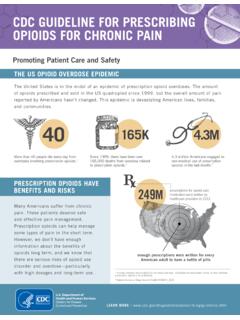Transcription of Academy of Acute Care Physical Therapy – APTA Task Force ...
1 1 Updated 2017 Laboratory Values Interpretation Resource Academy of Acute care Physical Therapy APTA Task Force on Lab Values 2017 Members James Tompkins, PT, DPT | Co-Chair Traci Norris, PT, DPT, GCS | Co-Chair Kim Levenhagen, PT, DPT, WCC | Co-Chair Kate Adeletti, PT, DPT, NCS Courtney Bryan, PT Malinda Brown-Crowell, PT, DPT, GCS Jamie Dyson, PT, DPT Komal Shah, PT, DPT, NCS Kathy Swanick, PT, DPT, OCS Julie Terrell, DPT Risa Maruyama, PT, NCS Caitlin Price 2012 Members Roya Ghazinouri | Chair Samidha Deshmukh Sharon Gorman, PT, DPTSc, FNAP, GCS Angela Hauber Mary Kroohs Elizabeth Moritz Babette Sanders, PT, DPT, MS, FAPTA Darin Trees, PT, DPT, CWS 2008 Members Holly McKenzie, PT, DPT Dawn Piech, PT, MPT Jim Smith, PT, DPT, MA Approved by Academy of Acute care Physical Therapy APTA Board of Directors: 8/2008, 12/2011, 1/20172 Evolution of the 2017 Edition of the Laboratory Values Interpretation Resource by the Academy of Acute care Physical Therapy As emerging research regarding early mobilization and advancements in medical practice is evolving, the Academy of Acute care Physical Therapy American Physical Therapy Association Task Force on Lab Values took on the mission of updating the Laboratory Values Interpretation Resource to better accommodate practitioners needs.
2 The task Force consisted of Physical therapists from across the country in various Acute care settings. Based on practitioners feedback, this document was adapted to improve usability in the busy Acute care setting. The task Force set out to use current literature from the past five years. Original sources were captured and referenced for each item. The task Force collaborated with university librarians to ensure the comprehensiveness of the literature search. After consulting with clinical lab scientists, the task Force was unable to identify a gold standard in regard to a laboratory guide listing reference values (see disclaimer). For the purpose of consistency, the task Force decided to use the reference values from one reputable laboratory values textbook, unless there was a clinical practice guideline related to that laboratory value.
3 Each laboratory test captured in this 2017 version has a brief explanation of the test or laboratory panel, reference values, clinical presentation, and clinical implications. In response to unmet clinical decision-making needs from membership thus far, updates have been made to the content from the previous version, and a new point-of- care document listing key laboratory tests has been created for this version. As the task Force closes its current work on this project, it does so in the understanding that this living document needs continuous updating to ensure that the needs of clinicians will be appropriately accommodated. Disclaimer The reference ranges and recommendations in this resource are based on the current, best-available evidence. Considering the absence of a universal reference range for any of the more than 5,000 lab tests in existence, accredited laboratories are required to establish and validate their reference values at least annually.
4 Thus, any given result should be interpreted based on the reference value of the laboratory in which the test was performed. Reference values must be updated each time a new reagent kit or diagnostic instrument is added. In addition, differences in patient populations (ethnicity, age, gender, behaviors, and culture) might result in variability of reference ranges. Abnormal values are defined as those results that are outside a specific range obtained from a cohort of healthy Physical therapists have the professional responsibility to provide excellent care , adhere to high standards, and collaborate with other healthcare providers to achieve optimal health outcomes for their patients. Acute care Physical therapists work in an environment that is quickly evolving and therefore should be knowledgeable regarding critical laboratory values and safe mobility recommendations.
5 Lundberg (1972) defined a critical value as a physiological state at such variance with normal as to be life threatening unless something is done promptly and for which some corrective action can be taken. 2 As critical values might evolve quickly in the Acute care setting, Physical therapists should be vigilant in reevaluating safe and effective patient management. Although the recommendations made in this document are evidence-based, the final judgment regarding the appropriateness of particular Physical Therapy interventions should be made by the clinician. The goal of clinical standardization is not to produce rigid guidelines; it is to establish an evidence- and consensus-founded treatment approach that could change and evolve based on the patient s clinical presentation and individual values, as well as expectations and preferences.
6 Today s electronic health record environment allows for fast retrieval of laboratory results. Test names and specific value ranges are easily visualized with high-priority findings ( critical alerts), having predetermined indicators or color highlights to bring attention to medical team. 3 Table of Contents 1. Understanding Lab Values a. Trends b. Risk vs. Benefit of the Therapeutic Intervention c. Acute vs. Chronic Considerations of the Therapeutic Intervention d. Gender, Race, and Culture Considerations e. Age Considerations 2. Complete Blood Count (CBC) a. White Blood Cells b. Platelets c. Hemoglobin d. Hematocrit 3. Electrolyte Panel a. Sodium (Na) b. Potassium (K) c. Calcium (Ca) d. Chloride (Cl) e.
7 Phosphate (PO4) f. Magnesium (Mg) 4. Kidney Function a. Blood Urea Nitrogen (BUN) b. Serum Creatinine 5. Endocrine a. Glucose/Criteria for Diagnosis of Diabetes b. Hgb A1C c. Thyroid Function Tests 6. Acid-Base Disorders a. Respiratory Alkalosis b. Respiratory Acidosis c. Metabolic Alkalosis d. Metabolic Acidosis 7. Liver Function/Hepatic Panel a. Serum Albumin/Pre-Albumin b. Serum Bilirubin c. Ammonia d. Model for End-Stage Liver Disease (MELD) e. FK Trough (Tacrolimus/Prograf Test) 8. Lipid Panel a. High-Density Lipoprotein (HDL) b. Low-Density Lipoprotein (LDL) c. Triglycerides d. Total Cholesterol 4 9. Bleeding Ratio/Viscosity a.
8 International Normalized Ratio (INR) b. Activated Partial Thromboplastin Time (aPTT) c. Prothrombin Time (PT) d. Anti-Factor Xa Assay e. D-Dimer f. Algorithm for Mobilizing Patients with Known Lower-Extremity Deep Vein Thrombosis 10. Cardiovascular-Specific Labs a. Troponin b. B-Type Natriuretic Peptide (BNP) c. Creatinine Kinase (CK) 11. References Appendix A: Point-of- care Document 5 1. Understanding Lab Values a. Trends Physical therapists should not rely exclusively on a single laboratory finding; instead, they should also consider a variety of other clinical factors. For instance, clinicians should be aware of the time the laboratory specimen was drawn, potential drug interactions, or the patient s recent meals. Likewise, it is important to understand the significance of trends in the values over time.
9 Electrolyte panels might change with intravenous infusions, medications, and diet. Patients with chronic medical conditions, such as anemia, might be asymptomatic during exercise, while a patient with a precipitous drop in hemoglobin and hematocrit might require urgent medical attention. When a patient presents with symptoms of a suspected myocardial infarction (MI), cardiac biomarker laboratory tests are ordered to assist with a differential diagnosis. Cardiac biomarkers are materials released into the bloodstream when the heart is under stress. Typically, under normal circumstances, these substances do not appear in circulation; however, when there is insufficient blood flow to the heart, markers associated with myocardial injury increase in a predictable fashion.
10 Up to 80% of patients with an Acute MI will present with an elevation of troponin within 3 hours of onset of chest However, not all patients with cardiac impairments present with obvious symptoms, and they might not have undergone diagnostic testing. It is not uncommon for patients with complex comorbidities and non-specific and subtle symptoms, including unexplained fatigue and weakness, to be referred to Acute care Physical Therapy . It is, therefore, prudent for therapists to be aware of the presence of cardiac biomarkers and potential delays in the diagnosing of cardiac ischemia. b. Risk vs. Benefit Considerations of the Therapeutic Intervention The fundamental consideration when reviewing patient laboratory findings is toward determining an appropriate plan of care and weighing the anticipated benefit of a Therapy intervention against the potential risk to the patient.







